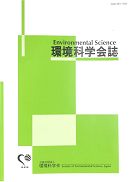
- Issue 6 Pages 159-
- Issue 5 Pages 70-
- Issue 4 Pages 54-
- Issue 3 Pages 42-
- Issue 2 Pages 24-
- Issue 1 Pages 1-
- |<
- <
- 1
- >
- >|
-
Yasuko KAMEYAMA, Miki SASAKI2020Volume 33Issue 6 Pages 159-171
Published: November 30, 2020
Released on J-STAGE: November 30, 2020
JOURNAL FREE ACCESSWe compared risk perceptions of climate change impacts among industry types around the world and in Japan by using the results of an international questionnaire conducted annually between 2011 and 2017. We used a topic model, a text-mining tool designed for discovery of hidden semantic structures in text, to examine each industry type’s perception of climate change risks that could affect its business. Worldwide, mining, food, energy, food and finance & insurance sectors, in particular, worried most about extreme precipitation and drought. In Japan, many companies, particularly those in transportation and energy industries, worried more about typhoons and hurricanes than the world average. Risk to reputation of companies was of most concern both worldwide (finance & insurance sector, in particular) and in Japan (telecommunication and raw material, in particular). Underlying concerns worldwide included direct physical damage to factories and infrastructure, increase in prices of materials and products, etc. Japanese companies were less concerned about effects in areas where their business is conducted and about risks to reputation with investors, but more concerned about regulatory risks, than the world average. From these results, this study was able to show differences of climate change risk perception among business sectors.
View full abstractDownload PDF (3616K) -
Haruko TOYONARI, Tomohiro TABATA2020Volume 33Issue 6 Pages 172-183
Published: November 30, 2020
Released on J-STAGE: November 30, 2020
JOURNAL FREE ACCESSThis study evaluated the positive and negative effects of each city selected as an environmental future city (11 cities and region) and environmental model city (23 cities) based on the environmental Future City Initiative (FCI) of Japan. 14 items and 16 indicators related to the environment, society, and economy were proposed, and target values of each indicator were established. As a result of evaluating each city using the proposed indicators, the achievement rate of the cities selected as an environmental future city was higher than the achievement rate of the entire comparison city. This result revealed that the selected cities might exemplify the ideal image of the environmental FCI. On the contrary, the achievement rate of the cities selected as an environmental model city was lower than the achievement rate of the comparison city. This result indicates that these cities might not consistently create environmental, social, and economic values because of their poor social and economic indicators. This study also evaluated the positive effects and future issues for individual cities based on the results of each indicator.
View full abstractDownload PDF (543K) -
Tatsuya FUJII, Masae MITSUHASHI, Ryuzo FURUKAWA2020Volume 33Issue 6 Pages 184-194
Published: November 30, 2020
Released on J-STAGE: November 30, 2020
JOURNAL FREE ACCESSIn order to evaluate the change of environmentally conscious behavior that promotes lifestyle change, it is necessary to grasp the behavior, which is caused by various and latent unconsciousness of people, and which is related to the social background, cultural background, environment, community, and so on. Therefore, the purpose of this research is to evaluate the changing of daily activities, by modeling a series of everyday actions that occur in the real world, and by clarifying common emotional concepts.
In this research, we focused on smiles of children who participated in the “Wood Education Workshop”, and the behavior that led to smiles was patterned. And by drawing an action decomposition tree based on ontology engineering, it is shown that the common concept of the person’s emotion in the process leading to smile can be approximated. In addition, by using this evaluation method based on the percentage of smiles, it was confirmed that the connection between emotions and actions was visible, and it is possible to infer the degree of smiles with environmentally conscious behavior.
View full abstractDownload PDF (1064K)
-
Suil PARK, Hirokazu KATO, Yuuki OHNO2020Volume 33Issue 6 Pages 195-207
Published: November 30, 2020
Released on J-STAGE: November 30, 2020
JOURNAL FREE ACCESSJapan is facing many threats such as a rapid population decline, a fast-aging society, climate change, major natural disasters, and an energy crisis. There is an urgent need to change the urban spatial structures so that they can respond flexibly to these threats.
The purpose of this paper is to develop an evaluation system to support local governments in the planning and implementation of various measures necessary to promote the transformation of the urban spatial structures. This evaluation system estimates the long-term changes in population and infrastructure using a cohort model. The system also allows us to track the gradual effects of urban spatial transformation measures during their implementation. This system can evaluate the long-term sustainability under ordinary conditions on each aspect of the Triple Bottom Line; environment, society, and economy. And the resilience against major natural disasters - divided into damage to life/health and damage to the environment - can be evaluated using a life expectancy index. Using this evaluation system, it is possible to obtain the following outcomes: climate change mitigation and adaptation measures, countermeasures against major natural disasters, measures to ensure energy security during emergencies, set a direction for the transformation of urban space structures in an era of declining population, and so forth. The system will enable the study of the effects of the introduction of various policies and technologies accompanying these outcomes.
View full abstractDownload PDF (2608K)
- |<
- <
- 1
- >
- >|